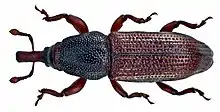Pentarthrum huttoni
Pentarthrum huttoni is a species of wood boring weevil in family Curculionidae. It has a mainly nearctic distribution, but has also been reported from several European countries. It was first reported in Austria in 2006 when it was found to be the cause of disintegration of historically significant 18th century softwood coffins in the crypt of St. Michael's church in the center of Vienna.[1]
| Pentarthrum huttoni | |
|---|---|
 | |
| Scientific classification | |
| Domain: | Eukaryota |
| Kingdom: | Animalia |
| Phylum: | Arthropoda |
| Class: | Insecta |
| Order: | Coleoptera |
| Infraorder: | Cucujiformia |
| Family: | Curculionidae |
| Genus: | Pentarthrum |
| Species: | P. huttoni |
| Binomial name | |
| Pentarthrum huttoni Wollaston, 1854 | |
These beetles prefer extremely high humidity (100%), and also prefer to attack wood that is already rotting. Most Central European records are from buildings.[2]
References
- Erhard Halmschlager; Christof Ladner; Petr Zabransky; Axel Schopf. "First record of the wood boring weevil, Pentarthrum huttoni, in Austria (Coleoptera: Curculionidae)". J Pest Sci (2007) 80:59–61.
- Folwaczny B (1983) 13. Unterfamilie: Cossoninae. In: Freude H, Harde KW, Lohse GA (eds) Die Käfer Mitteleuropas. Bd. 11. Goecke & Evers, Krefeld, pp 30–43
This article is issued from Wikipedia. The text is licensed under Creative Commons - Attribution - Sharealike. Additional terms may apply for the media files.